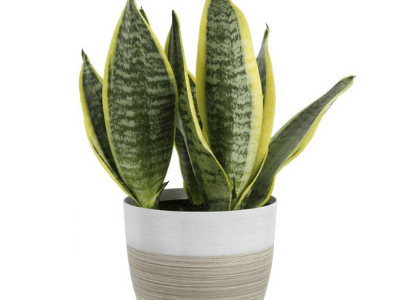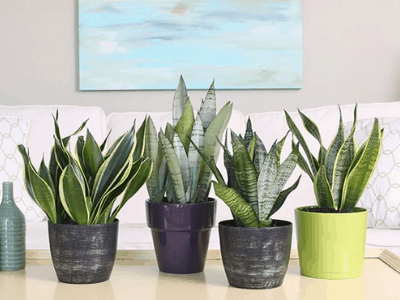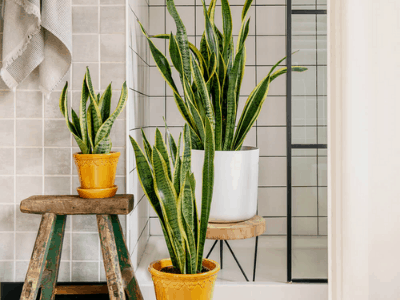
Sansevieria Trifasciata, Snake Plant Toxic? It’s a Myth?
Sansevieria trifasciata is the scientific name for snake plant, a member of the Asparagaceae family.
The plants are indigenous to Africa, and Brazil. There are approximately 70 species of these plants.
There are two kinds of this plant with flowering, and both spread by creeping rhizomes.
Leaf length and width are approximately 2.5 inches for the dark green leaves.
Dark green leaves with yellow edges cover some plants with varigated leaves.
These plants are mainly used for ornamental purposes in America.
In Africa, they are used in the production of fiber. Outdoors in warmer climates, these plants can be grown…
…but in colder climates they are used as a decorative houseplant.
You can use them for air purification, removing formaldehyde and benzene from the air.
The fact that they reach upwards makes them extremely desirable in Feng Shui.
When displaying Sansevieria near young children, you should be careful because it’s mildly toxic.
An ingestion can cause swelling of the throat and tongue, as well as problems with the digestive tract.
Here we have Jameson story about his experience encounter of snake plant toxic issue.
Let us hear Jameson’s story
When he was a little boy, my father used to tell me that if I ate the leaves of the snake plant it would make me sick.
That’s what they always said don’t they? If you’re not careful all your dinner will come up…
….and then you’ll have such a stomach ache. “Don’t touch it!”
My dad would warn when we passed them in the garden center. “They can make you sick.”
I believed him because he loved me so much and wouldn’t want to hurt me like this but one day…
….curiosity got the best of me and I reached out to touch a leaf-just for fun!
But nothing happened. And finally when I grown up older, I realized that when I was a little boy…
...I cant bear to chewing everything that’s looks good to me, and I have research about that snake plant…
...can cause you sick, if its accidentally eaten by humans or even your pets.
Now I know why my Dad always said don’t touch it every time I want to pick it leaves.

Because they do just fine in low light, snake plants are common in office spaces and in homes. They’ve even been used as herbal remedies in some parts of the world. But the plants are also poisonous if ingested. Large doses can cause nausea and vomiting, and the poison found in the plant has a numbing effect that can cause the tongue and throat to swell. The plants are more toxic to dogs and cats, which can suffer from nausea, vomiting, and diarrhea.
realtor.com, author from akc.org (American Kennel Club)
Here’s the main things that you should know!
Popular plant
Snake plants have adapted to grow in dry climates, but many succulents are too short to stand upright.
Tropical plants are known for their beautiful large leaves and colorful variations.
Leaves with a thick, buttery yellow edge are commonly found, while others have striking dark green stripes.
We also love this plant, since it complements pretty much any style of decor and looks great in arrangements!
It’s no secret that succulents are hardy, and snake plants are no exception.
They’re one of the easiest succulents to take care of, so we recommend them…
…to beginners and people with small thumbs. If you don’t water your snake plant for a month…
…it won’t die, so don’t let your inexperience with gardening keep you from owning this marvelous plant!
Despite the fact that snake plants are tough, you still might need our help to keep your plant looking its best.
The following article will give you information on what makes snake plants…
…so popular along with helpful care tips, with a few fun snake plant facts thrown in for good measure, so keep reading!

Here’s the thing….
Snake Plant Toxic, Is It Real?

The popular snake plant has been the subject of numerous articles claiming it is unhealthy.
Snake plant toxic rumor, has been spreading all over the gardener in the world.
It did cause quite a lot of panic, particularly because the article suggested that snake plants are poisonous…
…and harmful to health.
An article quoted UiTM researcher Dr Fatima Salim as saying that keeping snake plants…
….at home could result in increased microbial contamination that can harm certain individuals.
In her observations, she found that microorganisms flourish in soil more readily than in other environments.
These include bacteria, algae, fungus, protozoa, actinomycetes, and ciliates.
If people still want to grow plants indoors, she suggests using an alternative to soil.
The specific context in which Dr Fatimah is speaking is that of soil microorganisms posing a potential health risk…
…to those already with compromised immune systems.
According to a post recently posted by the Malaysian Poison Centre…
…where the plant has the active ingredient saponin, this plant has a higher risk of poisoning than other plants.
It can cause light symptoms of nausea, diarrhea, and rashes if large doses of the plant are ingested.
It is likely that ingesting the plant in large quantity is unlikely to be a threat to a reasonable adult in this case.
Taking the risks out of context suddenly causes the plant to sound terrifying…
…if you think there are millions of malicious little bugs in the soil, and that the plant can cause vomiting.
Healthy individuals are virtually unaffected by the plant.
Although we prefer to deny it, no living creature is 100% sterile.
Even our own bodies are home to billions of microscopic creatures, from our gut to our eyelashes.
Open windows at home introduce microorganisms and dust into your room, as well as a small amount of soil and dust.
This is usually not an issue for the majority of the population.
The risk may be greater for individuals who already have a compromised immune system or have been sick before.
Then simply move the plant to another room or outdoors if someone in your home suffers…
…from a weakened immunity or chronic health issues and having such plants is causing discomfort.
Additionally, the dose is also the poison in toxicology. A number of common plants and vegetables…
…also contain saponins, including peas, soybeans, lentils, onions, garlic, spinach, oats, tea, yam, and plenty more.
You can be sickened by snake plant saponin if you gorge on it like a sweet dessert at a buffet table.
But who does that? If you do, stop. Dogs and cats don’t get really sick from ingesting snake plants….
…but they won’t die from doing so either.
If this is a real concern for you, however, then simply keep your snake plant out of reach of children and pets.
Snake plants have increased in popularity because of their air-purifying properties…
…which have driven up demand from nurseries. As more and more people realize the importance of indoor plants…
…they have begun to add more of them to their living space. People may not always conduct thorough research…
…into the plants they bring home. However, context is always crucial: and in this case, unless there are individuals…
…who are immunocompromised or pets who have a dislike for the way snake plants taste, you should be fine.

Go on..
The Symptoms Of Poisoning?
Most animals avoid the unpleasant taste and burning sensation that follows which makes them avoid the plant.
However, curious pets like dogs and cats may be interested in consuming the plant.
When the plant sap and plant material has been ingested, children and animals will show a number of common symptoms, such as:
- Swelling on the lips, tongue, and mouth
- Nausea, vomiting and diarrhea
- Abdominal pain
- Loss of appetite
It may cause your pet to drool excessively because it increases salivation.
Cell death and the occurrence of blood cell rupture result from the foaming action of the poison…
…in the gastrointestinal tract.
______________________________________________________________________________________________________________________________
Sum Up
See having Snake plant is good choice for you to have! It’s cool, its famous, it’s easy to have and care!
What else do you need? In this pandemic time like this, is a good choice for you to have an new activity…
…and having snake plant is a good choice for you to have!
Conclusion
Last thing for sure. This plant need to be care carefully, remember plant need the “love” too.
Alright that’s all for today! Do you have any questions about all of this?
Or do you want to add some new fact about snake plant toxic issue?
Let me know your recommendation from the comment below.
I hope you can now take care your snake carefully and grow it big!
There are still many recent and interesting articles about Snake Plants as well…
as other unique information from All Things Gardener.
For further information and other inquiries you can contact us here. Thanks for reading this article! Bye!

